|
The Redoubt Battle
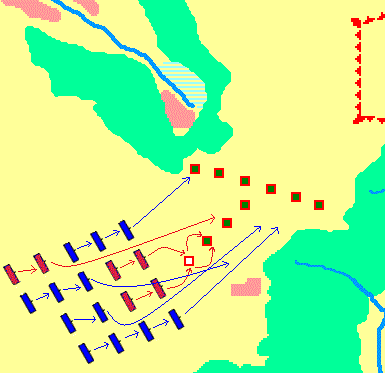 |
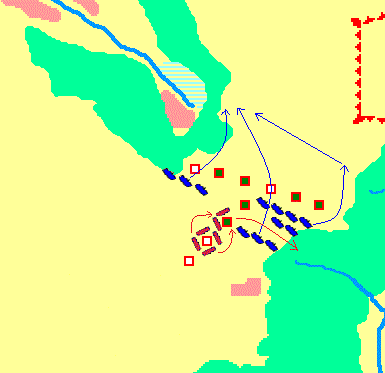 |
| The images above show
the Swedish infantry's movements during the redoubt battle. The
battalions led by
Roos which got separated from the main force are depicted with red
colour while the others are in blue. The green squares with red edges
are redoubts defended by the Russians while the white ones are
redoubts taken by the Swedes. In the upper right corner the Russian
fortified camp can be seen. |
The Swedish main force which
was intended to fight the battle of Poltava consisted of 18 infantry
battalions and 109
squadrons of cavalry and dragoons. It was forced to pass a system of ten
redoubts during its march north. The redoubts were manned by between 3
000 and 4 700 Russian infantry soldiers and they were also defended by a
cavalry force of about 8 000 men. The Swedish infantry marched in four
columns when they attempted to pass the redoubts. A third of the infantry
became however so involved in attacking redoubts and the Russian cavalry
that they did not notice when the rest of the army left the area. Ignorant
of the whereabouts of the main force these six lost battalions led by major
general Roos regrouped at the edge of a forest east of the redoubts (read
more about these battalions on this page).
Swedish Infantry Columns
(Battalions
in red got separated from the main force)
Swedish Cavalry Columns
(Rode behind the infantry and became divided into
two groups of three columns each during the redoubt battle, passing the
redoubts on separate sides)
Redoubt Garrison
There are several different
suggestions about how many and which regiments were manning the redoubts.
Depending on who you put most faith in the force consisted of either 3 000 men (Valery Moltusov), 4 000 men (Peter
Englund and Angus Konstam) or 4 730 men (Pavel Krutov and Nicholas Dorrell).
Furthermore Angus Konstam contradicts himself by also stating in a table
that redoubts were only manned by the Belgorodski Regiment (with one battalion in
the third redoubt and the second distributed between the other nine
redoubts). The latter is however based on an older and incorrect view. Moltusov
and Krutov are actually not in a disagreement regarding the number of
soldiers in the redoubts. Moltusov has however allocated 1 700 men of
this force south of the Russian fortified camp because he believes that
there were two additional and larger redoubts in that location, which
means that only 3 000 men remain in the ten redoubts blocking the
Swedish army's advance. Bertil
Wennerholm does not state how many men were in the redoubts but that the
number of battalions was 7 or 8.
A presentation of all the
details follows below (the information from Krutov has been passed on to
me by
Bengt Nilsson).
Regiments in green are the ones who are included in the redoubt garrison
by each historian and regiments in red are left out by the same.
Regiments in yellow are the ones Dorrell has guessed to be part of the
redoubt garrison.
| |
Wennerholm |
Krutov |
Moltusov |
Dorrell |
|
Belgorodski |
3 battalions |
1 067 |
1 067 (3 battalions) |
674 (2 battalions) |
| von Delden's |
|
893 |
|
|
| Ivangorodski |
|
|
|
707 (3 battalions) |
| Yamburgski (Vestov's) |
|
682 |
682 (2 battalions) |
800 (2 battalions) |
| Nelidov's |
|
749 |
749 (2 battalions) |
|
| K. Nekludov' |
2 battalions |
705 |
705 (2 battalions) |
650 (2 battalions) |
|
Nechaev's Streltsy Reg. |
2 or 3 battalions |
634 |
634 (2 battalions) |
250 (1 battalion) |
|
Pereslavski |
|
|
|
700 (2 battalions) |
|
Verden's |
|
|
893 (2 battalions) |
|
|
Sum |
7-8 battalions |
4 730 men |
4 730 or which 3 000 manned the ten redoubts |
2 031 known
1 750 speculative
949 completely unknown |
The uniforms for all the
possible regiments are shown below. Von Delden's Regiment is missing
because there were three regiment with that name and I do not know which
one of these Krutov referred to.
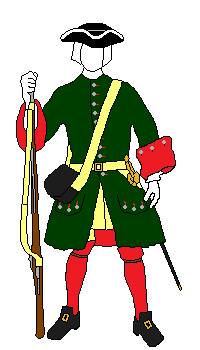 |
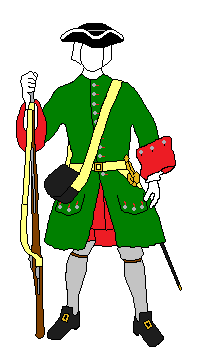 |
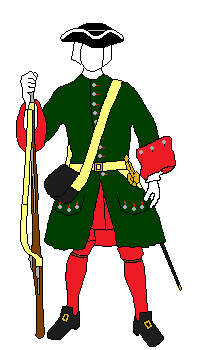 |
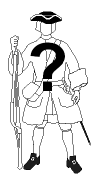 |
 |
 |
 |
 |
Belgorodski
Regiment |
Ivangorodski
Regiment |
Yamburgski
Regiment
(Vestovs reg.) |
Nelidov's
Regiment |
K. Nekludov's
Regiment |
Nechaev's Streltsy Regiment |
Pereslavski
Regiment |
Verden's
Regiment |
Russian Cavalry at the
Redoubts At the
redoubts there was also Russian cavalry commanded by Menshikov fighting the
advancing Swedish army. Its composition is not less uncertain than the
redoubt garrison.
According to the poorly preserved Plan boevye porjadki the cavalry
was deployed in two lines in the following manner:
First Line: (from right to left):
Unknown horse grenadier regiment, Life Regiment, Bauer's regiment (?),
Ingermanlandski, Vyatski, Sibirski, Archangelgorodski, unknown regiment, Moscowski,
unknown regiment, unknown horse grenadier regiment.
Second Line: Nizhegorodski, Nevski or Kievski,
Novotroitski,
Vladimirski. Another source
from the Swedish War Archive (Krigsarkivet) has the following order of
battle. The number of regiments is consistent with the 17 unnamed units in Peter
the Great's Plan
(which I have used for the Russian order of battle of the
Main battle).
During the redoubt battle at
least two of these regiments captured colours from the Swedish battalions. Novgorodski
Dragoon Regiment captured the colonel's colour and a company colour from Hälsinge
Regiment
(which fought as a part of the Dal-regiment during the battle of Poltava). Von der Roop's
horse grenadier were however even more successful and captured no less than 11
colours.
These were taken from Dal-regiment (3), Jönköping (3), Västerbotten
(1) and Närke-Värmland (4). However, of the colours taken from
Närke-Värmland Regiment only one was actually their own colour. One of
them came from Nyland regiment and two from Åbo &
Björneborg's 3-männings, all of which fought as part of Närke-Värmland Regiment
during the battle. Read also about
the order of battle for the main battle, or read about the fate of
the lost battalions led by Roos. |

